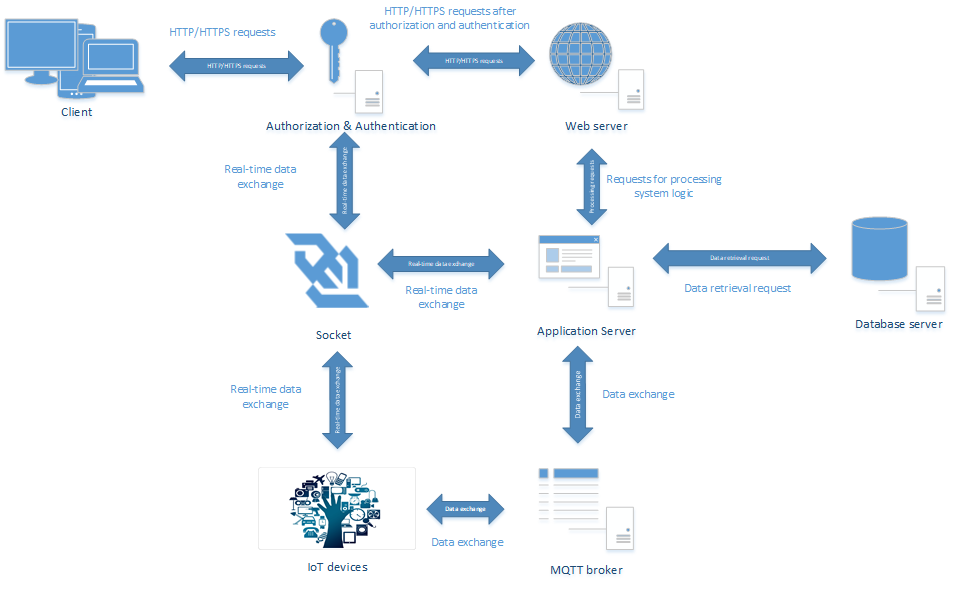Structural Interaction Diagram and Network Architecture
Structural Interaction Diagram and Network Architecture
Introduction
The architecture includes eight components: Client, Authentication and Authorization Service, Web Server, Application Server, Database, MQTT Broker, WebSocket, and IoT Devices. These components interact to ensure secure access, request processing, data storage, and data exchange with IoT devices.

Description of Structural Diagram Elements
Client:
- Description: The client is the device or application with which the user interacts. This could be a web browser, mobile application, or another device.
- Interaction: The client sends requests to the web server and can maintain a persistent connection with the application server via Socket for real-time data retrieval. The client also interacts with the authentication and authorization service to gain access to the system.
Authentication and Authorization Service:
- Description: This service is responsible for verifying the user's identity (authentication) and determining their access rights (authorization) to various system resources.
- Interaction: The client interacts with this service to obtain access confirmation. The application server may also consult this service to verify access rights.
Web Server:
- Description: The web server receives HTTP/HTTPS requests from the client and forwards them to the application server for processing.
- Interaction: The web server redirects requests to the application server, which handles the business logic.
Application Server:
- Description: The application server executes the system's core business logic, processes requests from the web server, and interacts with the database and other services.
- Interaction:
- Interacts with the database for data read and write operations.
- Communicates with the MQTT broker to exchange messages with IoT devices.
- Supports Socket connections with the client to transmit real-time data.
- Accesses the authentication and authorization service to verify user access rights.
Database:
- Description: The database stores all the necessary data for the system, such as user data, logs, IoT device parameters, and other information.
- Interaction: The application server accesses the database to perform data read and write operations.
MQTT Broker:
- Description: The MQTT broker is responsible for routing messages between the application server and IoT devices via the MQTT protocol, which is designed for lightweight data exchange in resource-constrained environments.
- Interaction: The application server interacts with the MQTT broker to send commands and receive data from IoT devices.
Socket:
- Description: Socket provides a persistent connection between the client and the application server, enabling bidirectional real-time data exchange.
- Interaction: The client establishes a Socket connection with the application server to receive real-time data updates.
IoT Devices:
- Description: IoT devices are physical devices equipped with sensors, actuators, and other components, connected to the internet to transmit data and receive commands.
- Interaction: IoT devices interact with the MQTT broker, sending data (e.g., sensor readings) and receiving commands (e.g., turning a device on/off).
Overall Interaction Flow:
- The client sends requests to the web server to perform various operations or retrieve data necessary for system operation.
- Before interacting with the core system, the client passes through the authentication and authorization service to verify its credentials.
- The web server forwards these requests to the application server, which processes the system logic.
- The application server interacts with the database for data storage and retrieval, as well as the authentication and authorization service to verify the client's access rights.
- The application server interacts with the MQTT broker to exchange data with IoT devices.
- The client maintains a Socket connection with the application server to receive real-time data, such as IoT device status updates.
- IoT devices exchange data with the application server via the MQTT broker, sending data and receiving commands.
Conclusion
This architecture provides comprehensive access management, secure data transmission, as well as a flexible and scalable infrastructure for integrating with IoT devices and processing real-time requests.